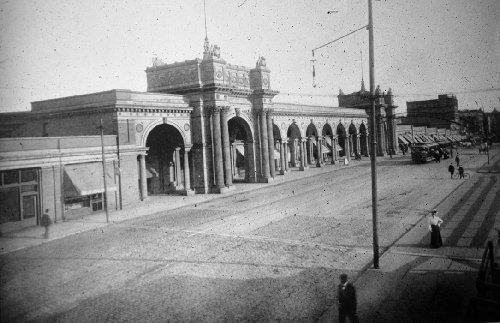
Union Station 1898

Union Station 1890s
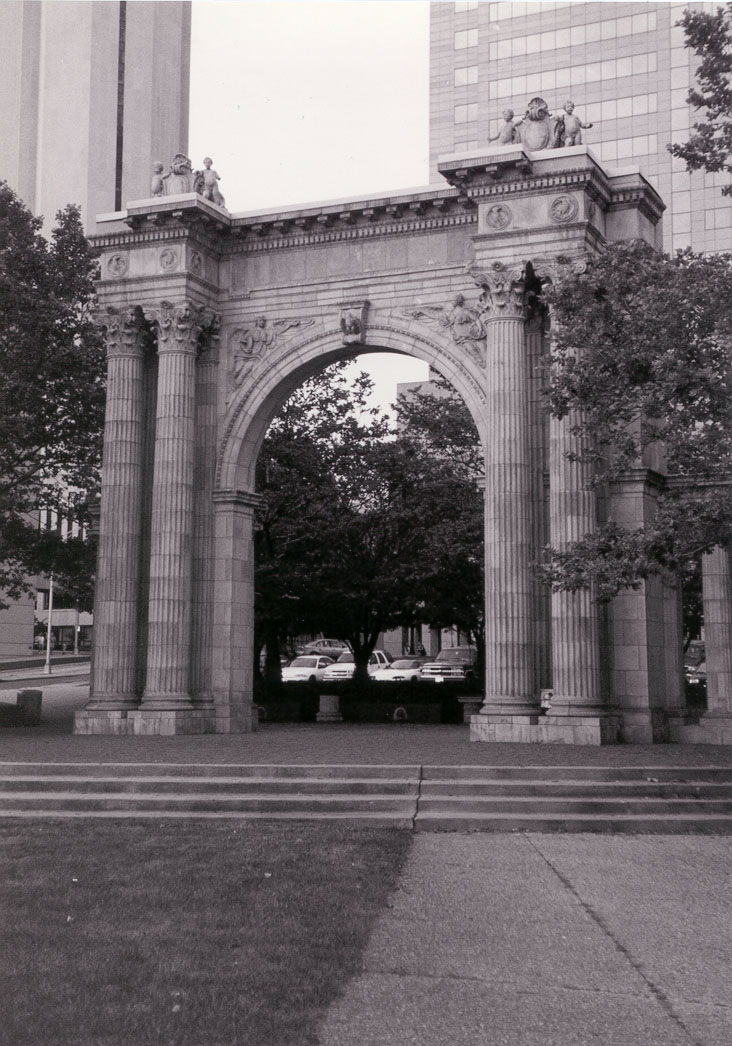
Photo of Arch Park by Patrick July 4th, 1998

Photo of Union Station remnants in Arch Park by Brian 3/21/99

Photo of Union Station remnants in Arch Park by Brian 3/21/99
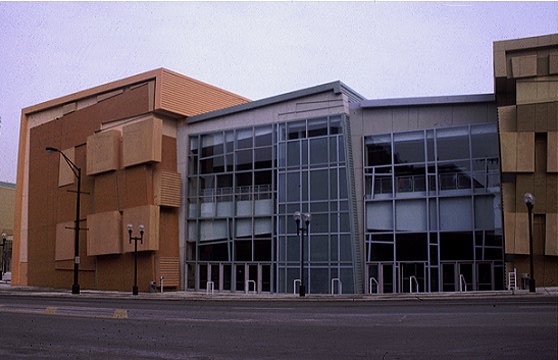
The Columbus Convention Center
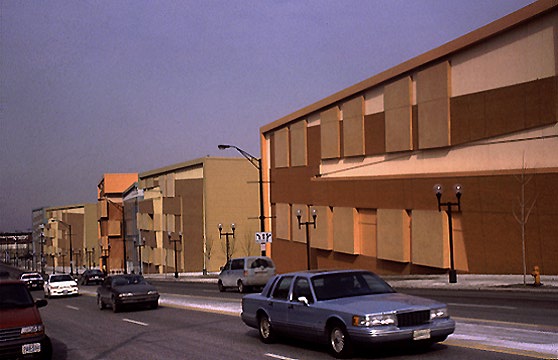
The Columbus Convention Center

Photo of Downtown Columbus
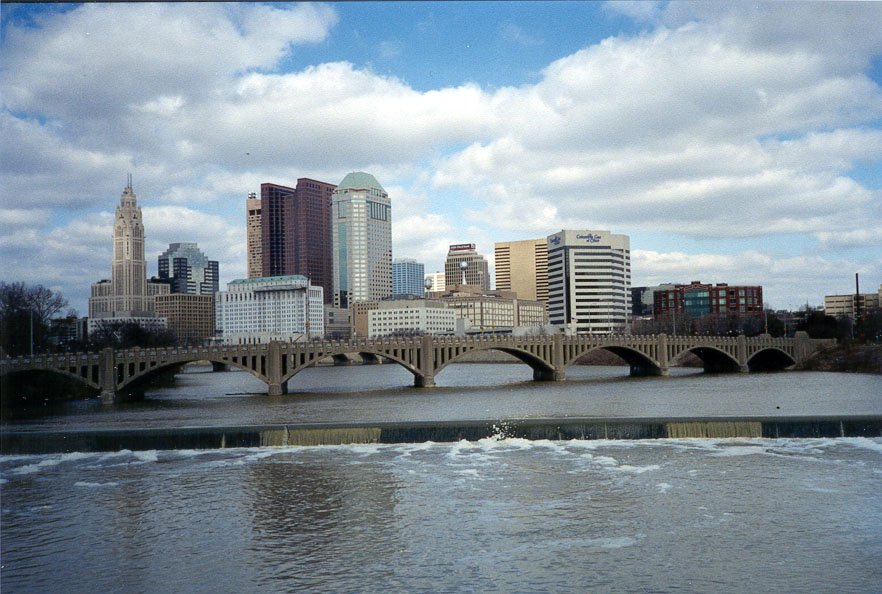
Photo of Downtown Columbus by Brian 3/21/99
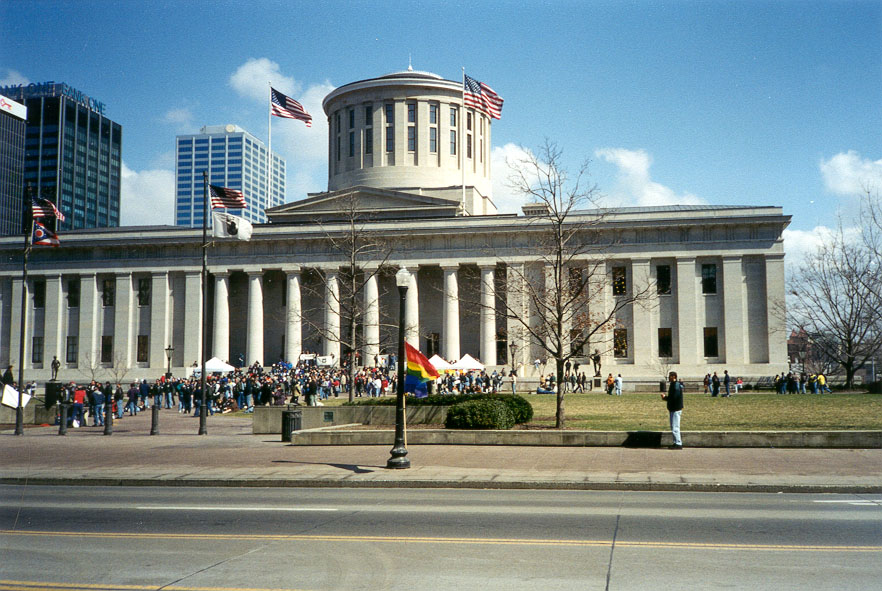
Photo of Ohio Statehouse by Brian 3/21/99
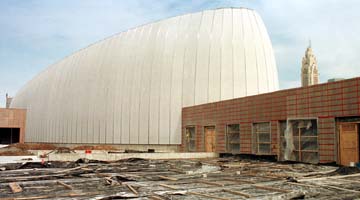
Photo of COSI 1999
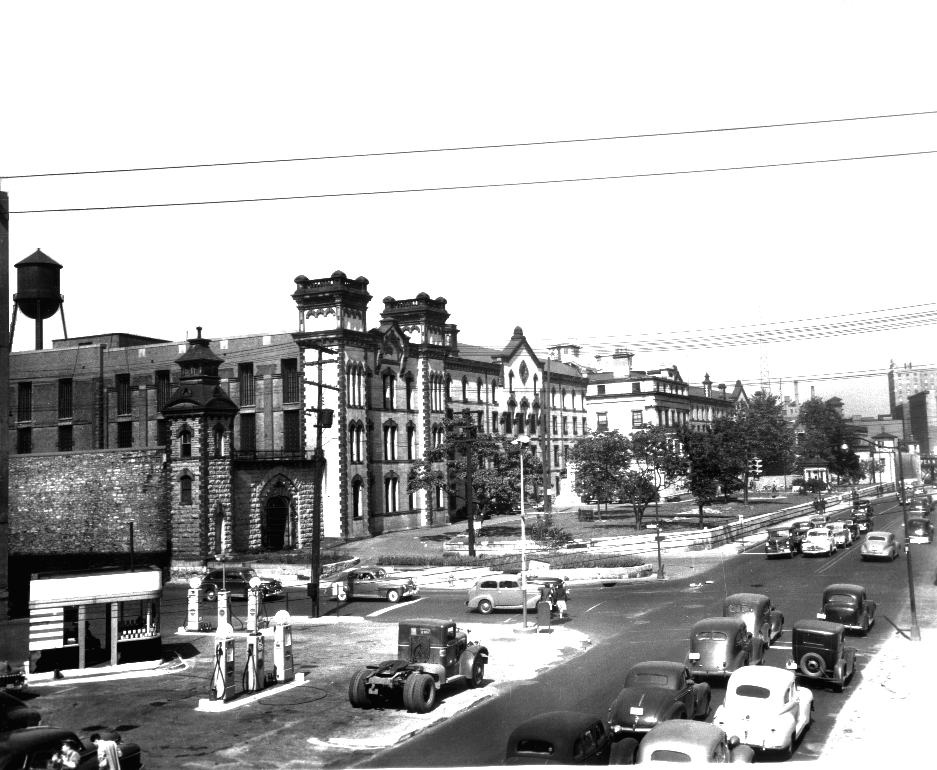
Photo of the old Ohio Penitentiary built in 1834
Historic Columbus, Ohio
Columbus City planners had a vision of uniform storefronts all set back at the same distance from the road along major corridors such as High Street. They often used zero lot lines. The storefronts had mixed use industrial, office, and retail downtown, with residential housing beyond. Since the late 19th century, much of the industry, office, and retail areas of downtown have been replaced by skyscrapers and surface parking lots. The commuter rail line and the Union Station in the Short North once was the train depot that was later replaced by Interstate 670. Most of the Union Station was demolished, but pieces of it remain to be displayed as a part of our history. Soon, a cap (roof garden) will be placed over Interstate 670 to preserve the historic Short North district. Also, the Union Station storefronts were replaced by the Columbus Convention Center. Today, the convention center sprawls along the link from the Short North to downtown, creating a disfunctional wall.
The last remaining remnants of the unique architecture of the Union Station were transported to a new location near the Nationwide Insurance building at Arch Park where it sat for a few years. Then it got in the way of new plans. The arches were moved to the Nationwide Arena District where the old Ohio Penitentiary once sat. Plans for a new parking structure are expected to take the place of Arch Park.
Along High Street, the character has also changed by allowing commercial chains to sprawl the city. For example, Kroger, UDF, Wendy's, Taco Bell, and McDonald’s defied the ideology of storefronts being set back at the same distance (zero lot line) that once created a uniform character. These chains also rely on large surface parking lots and some even have drive thru’s. Some positive aspect of late 19th century city planning still remains such as land set aside for parks. Goodale Park and Shiller Park are a couple of parks that were set aside as green space.
The Miranova project will soon be completed downtown along the Scioto riverfront. The development includes a residential tower and two corporate towers. Other riverfront development will soon be taking place. The currently walled-off riverfront in the near future will perhaps bring people closer to the water via boardwalks and retail. Bikeways are also under construction along the Scioto River. The I-670 and S.R. 315 are under construction as well.
Furthermore, development in Franklinton along the Scioto riverfront is taking place. The new Center of Science and Industry (COSI) has renovated parts of the old Central High School and made some additions. However, COSI appeared to put it's back to Franklinton, with a huge architectural concrete building shell. Franklinton, as many other areas in the urban core, has many abandoned warehouses that could be home to future development.
In addition, the Central Ohio Transit Authority (COTA) is proposing a commuter rail system that will reduce traffic conjestion in the city core.
What should be done? And how have things started to change? What design guidlines should be used?
A mixed use of high density retail, offices, and residential housing is the solution to High Street development outside of downtown. Retail and offices can be placed on the street level, while residential housing can be provided on the second or third story of buildings. To improve the quality of High Street, retail should line the street. Retail should replace the Columbus Convention Center façade. Having retail oreinted outward to High Street would invite people into the convention center. Currently, the convention center is a vast wasteland of dead business. We also need to develop the brownfields (abandoned land) and less of the sprawling greenfields in the suburbs. More parking garages should be provided as opposed to surface parking lots. And we need to support Cota with it's mass transit proposals! We need to make Columbus a walking city.
As for the riverfronts, we should preserve a setback boundary of green space (approximately 200 to 300 feet) which should act as a watershed for periodic flooding. These boundaries should be no-build zones for the public use -- not everyone has a river in their backyard. We need to rely less on dams which prevent water species from moving through territories. It also prevents the flushing of water, that is essential to good water quality.
We need to promote the diversity of culture in Columbus and preserve the historic characteristics. And the community needs to get more involved in the the decisions that change our landscape character. Your input can have a big impact on the appearance of our landscape.
The Columbus Dispatch
"Marching Arch"
March 18, 1999
With a 600-ton piece of Columbus history towering overhead, two men hunkered down in the muck and anticipated moving the landmark.
"What we need is some more snow and rough weather," said Bill Dingey, a devilish smile crossing his face. "Anybody can do it in good weather, but the good ones can do it through anything."
Dingey Movers of Zanesville, Ohio, and International Chimney of Williamsville, N.Y., are preparing to relocate Columbus' Union Station arch.
Richard T. Lohr, president of International Chimney, said the work of moving huge objects blends high-tech engineering with "child's play"—stacking blocks and moving them without letting them fall.
It requires equal amounts of art and science, he said.
"The engineering, the knowing how many steel beams to place underneath to distribute the weight -- that's the science of it. The art comes in from guys that have been doing this for years and just have a feel for things. Maybe they start jacking it up at a certain point because they just have a feel -- that's where the artistry comes in."
The 103-year-old arch is the city's only reminder of Union Station, a N. High Street complex torn down in 1976-77 to make way for the Ohio Center, the precursor to the larger Greater Columbus Convention Center.
When it was moved the first time, the 35-foot structure was disassembled, its terra-cotta elements numbered stone by stone.
The pieces sat in storage for a few years before the arch was reconstructed at tiny Arch Park, on Marconi Boulevard near Ludlow and W. Hickory streets Downtown.
This time around, it will be lifted and moved upright in one piece on a dozen dollies—"each the size of a Volkswagen," Lohr said.
It will travel less than 0.2 mile over the Conrail railroad tracks near Marconi, past the shadow of the Nationwide Arena construction site and to a new park Nationwide is developing in its Arena District.
"People don't realize this is an artifact, part of a much larger building," said architect Robert Loversidge of Schooley Caldwell Associates, hired to preserve the arch.
"I want to display it as a ruin, to make people aware that this is a piece of the city's past, rather than just a piece of architecture."
The relocation, expected to start next week, will take several days, Lohr said.
Traffic in the area will be detoured as warranted, he said.
Nationwide declined to say how much the relocation and restoration will cost.
Lohr, an employee of International Chimney since 1962, said the 75- year-old company has avoided significant damages in its moves.
Columbus' arch is a pup compared with the 4,000-ton Cape Hatteras Lighthouse, which International Chimney will move this summer.
The company also has relocated both the 3,000-ton Gem Theater in Detroit and the 2,000-ton Block Island Lighthouse in Rhode Island.
The arch -- to be lighted in its new position -- will face north toward the adjacent Nationwide Arena, in the aptly named Arch Plaza.
The plaza heads the 3-acre Arena Park, which will extend southward toward the Scioto River, stopping at Spring Street.
Some parts of the grassy, tree-lined Arena Park will be ready later this year, said its planner, Keith Myers, of Myers-Schmalen Berger landscape architects.
By early 2000, Myers said, all aspects will be completed -- with grass, park benches, sidewalks and wheelchair ramps.
The park won't have athletic fields or restrooms.
The $150 million Nationwide Arena, being developed by Nationwide Mutual Insurance, with The Dispatch Printing Co. as a 10 percent partner, will open in September 2000.
The Dispatch Printing Co. also has a 10 percent stake in Nationwide Realty Investors' development of the $300-plus million, 95-acre Arena District.
Steve Wright
The Columbus Dispatch
"A city tradition: pillaging history for parking lots"
March 22, 1999
The old Union Station is in the way again. But this time only a little bit of the 103-year-old building is left, so it's being moved rather than leveled.
The rest of the historic building was demolished two decades ago to make way for the Ohio Center, but the arch from the station was reassembled on a little patch of grass nearby.
Anyone who has lived in Columbus for any length of time, however, should have guessed the little patch of grass would suffer the fate of all little patches of grass Downtown and eventually become a parking lot.
To make way for the lot, the arch is moving to a new little patch of grass, where the old Ohio Penitentiary stood before it, too, got in the way.
History is always in the way. And, in Columbus, we do not grapple with our past. We bulldoze it.
We do not learn from history and so are doomed to repave it.
But we also like to save tiny bits of that history as evidence we are not cretins -- and to fill empty corners of our parks and museums.
A statue of King Gambrinus holds court at Sycamore and Front streets, though the brewery it once adorned met the wrecking ball long ago.
The old Franklin County Courthouse, torn down to make way for the new courthouse, lives on as a model in the new building.
And a tiny bit of the old Pen is in storage somewhere, someday to be assembled and displayed like the Union Station arch as a tribute to our heritage.
Several limestone balusters from the old Broad Street bridge are on display in my very own garden.
If Columbus were Paris, a flying buttress would be on display at Buttress Park. The former site of Notre Dame cathedral would be occupied by La Quickie Boutique.
Had Athens been founded on the Scioto instead of the Aegean, the Athens Historical Society would proudly display photos of the Parthenon as it was before demolition. The Acropolis would house a short-term parking lot.
Columbus is not alone. Many American cities are paving the past. Saving little bits of history and shuffling them around has become a big business. Architectural-salvage firms are booming, perhaps because there is so much to salvage.
Columbus also is booming, but that's despite our lack of a sense of history, not because of it.
The past need not stand in the way of progress. Progress is great. Shiny new buildings are cool. Parking lots are necessary.
A city should not be entombed in regulatory amber; preservation should be an option, not a mandate. But it should be an option that Columbus property owners -- including the city and state -- consider more seriously than they seem to do now.
Columbus has had several preservation success stories.
The rescue of the Ohio Theatre in 1969 served as a model for other cities. And recent successes -- such as the Southern Theatre, the Fifth/Third Bank Building, and the loving restoration of the Statehouse -- hint that respect for our architectural heritage might be growing.
Maybe we're approaching a day when the bulldozer is no longer the tool of choice for historical preservation.
Maybe our movers and shakers will quit moving and shaking every 100-year-old structure in reach.
Maybe we won't need out-of-the-way niches to display parts of buildings, because we will start saving the buildings themselves.
Maybe the old Pen and the Central Ohio Psychiatric Hospital will be the last great old buildings to be unceremoniously leveled in central Ohio.
And maybe gargoyles will fly from my buttress.
Steve Stephens is a Dispatch Metro columnist. He can be reached at 614-461-5201 or sstephen@dispatch.com
The Columbus Dispatch
Huge Arch Creeps Toward New Home
March 26, 1999
It's where brain meets brawn.
Planning is essential, but all the computer calculations, college degrees and fancy gadgets in the world won't help when it's time to bring in the heavy equipment and move a mammoth piece of architecture.
Bill Dingey, a third-generation house mover, knows it. Valerie Dumont, an expert flown in from New England, knows it, too.
They're the principals of the team that's moving the massive Union Station arch from Arch Park on Marconi Boulevard to a new park being developed near Nationwide Arena -- a trip of less than two-tenths of a mile.
Dingey, president of Dingey Movers, based in Zanesville, and Dumont, from the Connecticut office of International Chimney, based in Buffalo, N.Y., led dozens of workers in the inch-by-inch journey yesterday.
A day's worth of work moved the 103-year-old landmark all of 70 feet closer to its new home at Arch Plaza, the anchor of the 3-acre Arena Park. Nationwide Realty Investors, the arm of the company that is developing the Nationwide Arena District, is paying for the relocation.
The arch is the city's only reminder of Union Station, a N. High Street complex torn down in 1976- 77 to make way for the Ohio Center, the precursor to the larger Greater Columbus Convention Center.
Lifelong Columbus resident Christina Spantithos couldn't resist capturing a piece of moving history on her tiny camera yesterday.
The Beechwold woman, Downtown with her mother to watch the raising of the Greek flag during a Statehouse observation of Greek independence day, stopped by the construction site and starting snapping pictures.
"I'll probably get a (parking) ticket, but this has too much meaning for me," said Spantithos, who remembers the Daniel Burnham- designed station and laments its demolition.
She said the arch also has special meaning to her family because her brother and his new wife posed for pictures under it when the two married in 1983.
"It's the history of Columbus, what's left of it," Spantithos said. "If you don't have your history, you have nothing."
Before the arch reaches its new digs in the shadow of Nationwide Arena, it must travel over the Conrail railroad tracks near Marconi. That track crossing will happen Saturday. The move should be complete by Monday.
Dumont said the track crossing "is the biggest bureaucratic challenge," because it has to be timed just right by Conrail, which has to reroute trains. She said the biggest nail-biter of the move itself was lifting the arch out of the ground and placing it on a dozen hydraulic jacks.
The arch -- which weighs just less than 400 tons and tips the scales at 455 tons including steel fixed to its feet to secure the move -- came out of the ground and crept toward the railroad tracks without a hitch, Dumont said.
"It's pure physics, simple science," Dingey said.
Steve Wright
The Columbus Dispatch
"Save Columbus: Union Station Arch is Symbol of City's Past"
March 29, 1999
A hue and cry went up when Union Station on N. High Street was demolished in 1976 to make way for the Ohio Center, the city's first convention center.
That flap comes to mind because the Union Station arch, all that was preserved from the station, is being moved.
When preservationists perceived they couldn't save the station, they formed an ad hoc group that raised money to preserve the massive arch and move it near Marconi Boulevard, where the city promised to maintain a small park. People who worked nearby would have picnic lunches in the park, but the site hardly had high visibility.
Time marches on, and now the arch has been moved to a park that Nationwide Insurance is developing in the Arena District. Is this another desecration, sure to set off fireworks among preservationists? Not a bit. There has been no opposition to the new location, and there is a feeling that the arena site will be more accessible.
As the number of passenger trains moving through Columbus declined, Amtrak stopped using Union Station and eventually abandoned the city. And developers had their eyes on the prime real estate.
The Downtown arch does not exactly measure up to the Arc de Triomphe in Paris, but at 400 tons, it is a sizable piece of history. Before being dismantled, it was part of an arcade leading from High Street to the train station.
It is important that at least a piece of the station remains and has found a good home. Fiddler on the Roof trumpeted the importance of tradition -- and it is as important in an American city as it is in a Russian shtetl. Americans like to feel they are connected to their past. Consider that German Village is one of the three most popular destinations for visitors to this city.
City leaders need to pay attention to preserving what is best here. It is instructive that not long ago, a survey of chief executive officers nationwide found an alarming number had no image of Columbus, at all.
Fortunately, an appreciation of Columbus' past appears to be building. For instance, in the space of a few years the Southern Theatre was restored, as were the Smith Brothers Hardware Co. and the Beggs Building. The latter is now the Fifth Third Building. Red Roof Inns restored an 89-year- old warehouse Downtown, an improvement over another cookie-cutter motel.
A city that doesn't move forward is doomed to be left behind. Surely, Columbus' prosperity stamps it as forward-looking. But it is important to be linked to one's past, too, and Columbus may be learning that lesson.
The Columbus Dispatch
"Monumental move has arch sitting pretty"
March 31, 1999
For the third time, the Union Station arch has a new home -- and Nationwide officials hope this time is the last time.
The 103-year-old landmark spent the majority of its life on N. High Street. It was part of a complex torn down in the mid-1970s to make way for the Ohio Center, the precursor to the larger Greater Columbus Convention Center.
The arch, weighing slightly less than 400 tons, then spent two decades in Arch Park on Marconi Boulevard.
Last week, it began its move over the Conrail railroad tracks near Marconi. Yesterday, the arch was resting in its new home at Arch Plaza, the anchor of the 3-acre Arena Park.
Officials from Nationwide Realty Investors, the arm of the company that is developing the Nationwide Arena District and paying for the arch relocation and renovation, said the move went smoothly.
It will take several days for crews to remove dollies and steel attached to the arch's base for the move. Arch Plaza is scheduled to be completed by summer 2000, but much of Arena Park will be open to the public by this fall.
Steve Wright